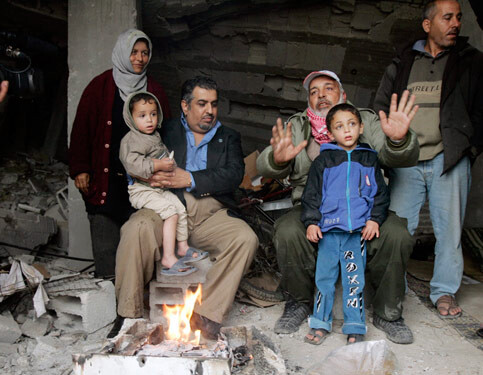The Electronic Intifada 3 March 2009

Abdul Aziz Arrukban with displaced families in the Ezbet Abed Rabu area of East Jabaliya, the Gaza Strip. Their homes were destroyed by Israeli forces during a three-week conflict that ended on 18 January. (Erica Silverman/IRIN)
GAZA CITY (IRIN) - On his first visit to the Occupied Palestinian Territories, the United Nations Secretary-General’s Special Humanitarian Envoy, Abdul Aziz Arrukban, met with aid agency officials to discuss better ways of bringing in relief supplies and with Gaza residents to assess how much aid they were actually receiving.
“The borders are still closed and goods and building materials still can’t enter,” said Arrukban, a Saudi national who reports directly to UN Secretary-General Ban Ki-moon and Under-Secretary-General for Humanitarian Affairs John Holmes.
Since Israel’s 23-day military campaign in the Gaza Strip ended on 18 January, Arrukban has brokered more than $50 million in humanitarian aid from two Gulf countries, channeled via UN agencies, for the dilapidated coastal territory.
Qatar donated $40 million, of which $30 million went directly to UN agencies in Gaza and $10 million to the Central Emergency Response Fund (CERF), a stand-by UN fund established to enable the delivery of humanitarian assistance to those affected by natural disasters and armed conflicts. Gaza received $8 million in aid from the CERF immediately after the conflict.
Saudi Arabia donated $10.5 million, of which the UN agency for Palestine refugees (UNRWA) received $6 million for emergency food assistance and $500,000 for fuel; and $4 million went to the World Food Programme (WFP).
Acting as a bridge between UN humanitarian agencies and donors, governments and the private sector in the Middle East and North Africa, Arrukban toured Gaza to see for himself the extent of the damage in the enclave and to ensure that relief supplies were actually reaching the most vulnerable people in the Strip.
Regular border closures
The most pressing issue, aid officials told him, was Israel’s regular closure of border crossings into Gaza.
“Aid cannot be delivered unless the crossings are opened,” Christina Blunt, head of the UN Office for the Coordination of Humanitarian Affairs (OCHA) in Gaza, said during a briefing for Arrukban by heads of UN agencies in the enclave.
Over the past few weeks, about 120 trucks a day have been allowed to enter Gaza by the Israeli authorities, OCHA estimated, with about half that number for the private sector. In May 2007, before Hamas took control over the Gaza Strip and a subsequent embargo was placed on the enclave, about 475 trucks entered daily.
The UN envoy held meetings with officials from the Egyptian Red Crescent to discuss a mechanism to facilitate the entry of approximately 9,000 metric tons of what a recent Logistics Cluster report described as “unsolicited bilateral donations” to the people of Gaza. The aid, a large portion lacking documentation and designated recipient organizations in Gaza, has been denied entry into Israel and is being held in al-Arish, Egypt.
The Egyptian government has mandated the Egyptian Red Crescent to take custody of these donations, which originate from a number of Middle Eastern countries, such as Egypt, Saudi Arabia, Qatar, Kuwait, Jordan, Yemen, and Libya.
While some aid has entered Gaza, 1,700 pallets of humanitarian items are also stuck in Israel, according to the Logistics Cluster report.
Residents desperate
Aid is desperately needed by some of the 1.5 million residents of the 365 square-kilometer Strip, the 12th most densely populated place on earth. In torrential rain, Arrukban visited displaced residents in the Abed Rabbo area of Jabaliya.
“I am afraid to rebuild my home again,” Henan Salah, a 40-year-old mother, said. She and her six children are now living in the one room still standing after an Israeli missile struck her home. Salah said that just eight months ago she had rebuilt her home after it was destroyed by Israeli forces in an incursion then. Unable to buy cooking gas, she had to break up the remains of her furniture to use as firewood.
Tented communities have sprung up in areas where Israeli tanks inflicted heavy damage in densely populated areas.
“The coldness is killing us,” Khalil al-Gharabli said, pointing at his wife and six children sitting on a donkey cart beside their demolished home. Al-Gharabli, now unemployed, used to work as an agricultural laborer in Israel.
Donor concerns
Arrukban said that he must assuage donor concerns that their funds will be wasted if re-constructed homes and agricultural lands are repeatedly destroyed during Israeli invasions.
Perhaps just as importantly, he said he hoped to increase confidence in GCC countries that the multilateral humanitarian system works.
UN officials estimate that as much as 90 percent of Saudi donations to Gaza are bilateral — to the government, non-governmental organizations and charities. Donors will be encouraged to give cash, but if they choose to donate goods, to make sure it is allocated to a recipient organization in Gaza to ensure their entry.
Arrukban travels to Doha and Riyad next seeking contributions from donors to facilitate reconstruction and economic recovery in Gaza.
This item comes to you via IRIN, a UN humanitarian news and information service, but may not necessarily reflect the views of the United Nations or its agencies. All IRIN material may be reposted or reprinted free-of-charge; refer to the copyright page for conditions of use. IRIN is a project of the UN Office for the Coordination of Humanitarian Affairs.


